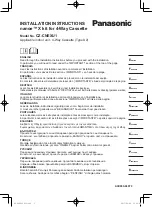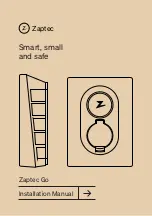
15
BOSCH PERFORMANCE LINE
Bicycle Owner’s Manual
15
2. Wheels with cam action systems
There are currently two types of over-center cam wheel
retention mechanisms: the traditional over-center cam
(fig. 8a) and the cam-and-cup system (fig. 8b). Both use
an over-center cam action to clamp the bike’s wheel in
place. Your bicycle may have a cam-and-cup front wheel
retention system and a traditional rear wheel cam action
system.
a. Adjusting the traditional cam action mechanism
(fig. 8a)
The wheel hub is clamped in place by the force of
the over-center cam pushing against one dropout and
pulling the tension adjusting nut, by way of the skewer,
against the other dropout. The amount of clamping force
is controlled by the tension adjusting nut. Turning the
tension adjusting nut clockwise while keeping the opened
cam lever from rotating increases clamping force; turning
it counterclockwise while keeping the opened cam lever
from rotating reduces clamping force. Less than half a
turn of the tension adjusting nut can make the difference
between safe clamping force and unsafe clamping force.
WARNING: The full force of the cam action is needed
to clamp the wheel securely. Holding the nut with
one hand and turning the lever like a wing nut with
the other hand until everything is as tight as you can get it
will not clamp a cam action wheel safely in the dropouts.
See also the first WARNING in this Section, p. 18.
b. Adjusting the cam-and-cup mechanism (fig. 8b)
The cam-and-cup system on your front wheel will have
been correctly adjusted for your bicycle by your dealer.
Ask your dealer to check the adjustment every six months.
Do not use a cam-and-cup front wheel on any bicycle other
than the one for which your dealer adjusted it.
3. Removing and Installing wheels
WARNING: If your bike is equipped with a hub brake
such as a rear coaster brake, front or rear drum,
band or roller brake; or if it has an internal gear rear
hub, do not attempt to remove the wheel. The removal and
re-installation of most hub brakes and internal gear hubs
requires special knowledge. Incorrect removal or
assembly can result in brake or gear failure, which can
cause you to lose control and fall.
CAUTION: If your bike has a disc brake, exercise care in
touching the rotor or caliper. Disc rotors have sharp edges,
and both rotor and caliper can get very hot during use.
a. Removing a disk brake or rim brake Front Wheel
(1) If your bike has rim brakes, disengage the brake’s
quick-release mechanism to increase the clearance
between the tire and the brake pads (See Section 4.C fig.
11 through 15).
(2) If your bike has cam action front wheel retention,
move the cam lever from the locked or CLOSED position
to the OPEN position (figs. 8a & b). If your bike has
through bolt or bolt-on front wheel retention, loosen
the fastener(s) a few turns counter-clockwise using an
appropriate wrench, lock key or the integral lever.
(3) If your front fork has a clip-on type secondary
retention device, disengage it. If your front fork has an
integral secondary retention device, and a traditional cam
action system (fig. 8a) loosen the tension adjusting nut
enough to allow removing the wheel from the dropouts.
If your front wheel uses a cam-and-cup system, (fig. 8b)
squeeze the cup and cam lever together while removing
the wheel. No rotation of any part is necessary with the
cam-and-cup system.
You may need to tap the top of the wheel with the palm
of your hand to release the wheel from the front fork.
b. Installing a disk brake or rim brake Front Wheel
CAUTION: If your bike is equipped with a front disk
brake, be careful not to damage the disk, caliper or
brake pads when re-inserting the disk into the
caliper. Never activate a disk brake’s control lever unless
the disk is correctly inserted in the caliper and the bike is
in an upright position. See also Section 4.C.
(1) If your bike has cam action front wheel retention,
move the cam lever so that it curves away from the wheel
(fig. 8b). This is the OPEN position. If your bike has
through bolt or bolt-on front wheel retention, go to the
next step. Make shure that the brake disc is positioned on
the correct side so it can fit in the caliper.
(2) With the steering fork facing forward, insert the
wheel between the fork blades so that the axle seats
firmly at the top of the fork dropouts. The cam lever, if
there is one, should be on rider’s left side of the bicycle
(fig. 8a & b). If your bike has a clip-on type secondary
retention device, engage it.
(3) If you have a traditional cam action mechanism:
holding the cam lever in the ADJUST position with your
right hand, tighten the tension adjusting nut with your left
hand until it is finger tight against the fork dropout (fig.
8a). If you have a cam-and-cup system: the nut and cup
(fig. 8b) will have snapped into the recessed area of the
fork dropouts and no adjustment should be required.
(4) While pushing the wheel firmly to the top of the slots
in the fork dropouts, and at the same time centering the
wheel rim in the fork:
(a) With a cam action system, move the cam lever
upwards and swing it into the CLOSED position (fig. 8a
& b). The lever should now be parallel to the fork blade
and curved toward the wheel. It should point backwards
to avoid being opened by contact wile riding. To apply
enough clamping force, you should have to wrap your
fingers around the fork blade for leverage, and the lever
Содержание bosch performance series
Страница 1: ...1 BOSCH PERFORMANCE LINE MANUAL GAZELLE WITH BOSCH PERFORMANCE LINE SYSTEM ...
Страница 71: ...37 BOSCH PERFORMANCE LINE ...
Страница 72: ...38 GAZELLE MANUAL ...
Страница 73: ...39 BOSCH PERFORMANCE LINE ...
Страница 74: ...ROYAL DUTCH GAZELLE N V Wilhelminaweg 8 6951 BP Dieren The Netherlands ...
















































